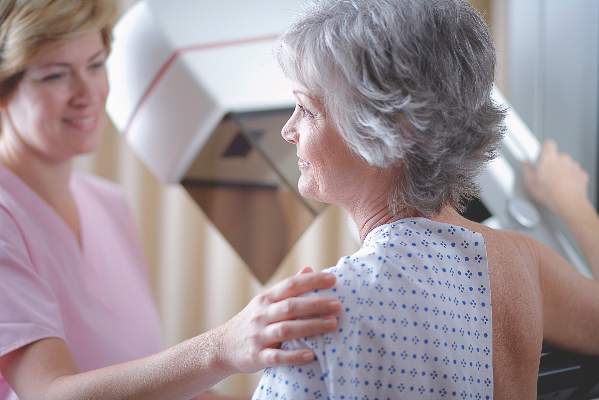User login
The U.S. Preventive Services Task Force is continuing to recommend routine mammograms every 2 years for women starting at age 50, according to newly released draft screening recommendations for breast cancer.
The draft recommendations, issued on April 20, largely reaffirm the group’s advice from 2009. Recent research findings have not altered the USPSTF’s key recommendation: routine mammograms every 2 years for women 50-74 years old. The USPSTF gave this recommendation a grade B, meaning that the evidence is strong enough for clinicians to adopt this practice. For women 75 years or older, the evidence remains inadequate to recommend for or against routine mammography.
For women 40-49 years old, the task force continued to state that the decision to start screening should be an individual one. The USPSTF gave mammography screening in this age group a grade C, concluding that the benefit of screening mammography outweighs the harms, but only by a small amount.
“Women who place a higher value on the potential benefit than the potential harms may choose to begin biennial screening between the ages of 40 and 49 years,” the task force members wrote.
In contrast, the American College of Obstetricians and Gynecologists, the American Cancer Society, the American College of Radiology, and the Society for Breast Imaging all recommend annual mammography starting at age 40.
The USPSTF is not advising against screening at age 40, but the task force members wrote that younger women with average breast cancer risk “must weigh a very important but infrequent benefit (small reduction in breast cancer deaths) against a group of meaningful and much more common harms (overdiagnosis and overtreatment; unnecessary and sometimes invasive follow-up testing; psychological harms associated with false-positive tests; and false reassurance from false-negative tests).”
The USPSTF’s recommendations apply to asymptomatic women without preexisting breast cancer, a previously diagnosed high-risk breast lesion, underlying genetic mutations, or a family history that puts them at high risk.
New for 2015, the group also weighed in on tomosynthesis (3-D mammography) for primary screening, and additional screening – ultrasound, MRI, tomosynthesis, or other methods – in women with dense breasts but otherwise negative mammogram results.
“In both cases, while there is some information about the accuracy of these modalities, there is no information on the effects of their use on health outcomes, such as breast cancer incidence, mortality, or overdiagnosis rates,” the USPSTF wrote.
The task force did not recommend for or against their use, stating only that more research is needed.
“From the limited data available, tomosynthesis appears to reduce recall rates for false-positive tests, compared with 2-D digital mammography alone. Available data also suggest that tomosynthesis increases the cancer detection rate, compared with 2-D digital mammography alone. However, current study designs do not answer the question of whether all of the additional cancers detected would have become clinically significant or whether there is an incremental clinical benefit to detecting these cancers earlier,” the task force members wrote.
Also, as currently practiced in most settings, tomosynthesis exposes women to about twice the amount of radiation of 2-D digital mammography. Tomosynthesis may also increase the rate of breast biopsy in women with abnormal findings, compared with 2-D digital mammography, according to the draft recommendations.
Meanwhile, “many important questions remain about the potential role of breast density in individualizing screening approaches; the current evidence is insufficient to recommend a specific screening strategy for women with increased breast density,” the group said.
The draft recommendations are available at www.screeningforbreastcancer.org. The group will accept public comments on the recommendations through May 18.
The U.S. Preventive Services Task Force is continuing to recommend routine mammograms every 2 years for women starting at age 50, according to newly released draft screening recommendations for breast cancer.
The draft recommendations, issued on April 20, largely reaffirm the group’s advice from 2009. Recent research findings have not altered the USPSTF’s key recommendation: routine mammograms every 2 years for women 50-74 years old. The USPSTF gave this recommendation a grade B, meaning that the evidence is strong enough for clinicians to adopt this practice. For women 75 years or older, the evidence remains inadequate to recommend for or against routine mammography.
For women 40-49 years old, the task force continued to state that the decision to start screening should be an individual one. The USPSTF gave mammography screening in this age group a grade C, concluding that the benefit of screening mammography outweighs the harms, but only by a small amount.
“Women who place a higher value on the potential benefit than the potential harms may choose to begin biennial screening between the ages of 40 and 49 years,” the task force members wrote.
In contrast, the American College of Obstetricians and Gynecologists, the American Cancer Society, the American College of Radiology, and the Society for Breast Imaging all recommend annual mammography starting at age 40.
The USPSTF is not advising against screening at age 40, but the task force members wrote that younger women with average breast cancer risk “must weigh a very important but infrequent benefit (small reduction in breast cancer deaths) against a group of meaningful and much more common harms (overdiagnosis and overtreatment; unnecessary and sometimes invasive follow-up testing; psychological harms associated with false-positive tests; and false reassurance from false-negative tests).”
The USPSTF’s recommendations apply to asymptomatic women without preexisting breast cancer, a previously diagnosed high-risk breast lesion, underlying genetic mutations, or a family history that puts them at high risk.
New for 2015, the group also weighed in on tomosynthesis (3-D mammography) for primary screening, and additional screening – ultrasound, MRI, tomosynthesis, or other methods – in women with dense breasts but otherwise negative mammogram results.
“In both cases, while there is some information about the accuracy of these modalities, there is no information on the effects of their use on health outcomes, such as breast cancer incidence, mortality, or overdiagnosis rates,” the USPSTF wrote.
The task force did not recommend for or against their use, stating only that more research is needed.
“From the limited data available, tomosynthesis appears to reduce recall rates for false-positive tests, compared with 2-D digital mammography alone. Available data also suggest that tomosynthesis increases the cancer detection rate, compared with 2-D digital mammography alone. However, current study designs do not answer the question of whether all of the additional cancers detected would have become clinically significant or whether there is an incremental clinical benefit to detecting these cancers earlier,” the task force members wrote.
Also, as currently practiced in most settings, tomosynthesis exposes women to about twice the amount of radiation of 2-D digital mammography. Tomosynthesis may also increase the rate of breast biopsy in women with abnormal findings, compared with 2-D digital mammography, according to the draft recommendations.
Meanwhile, “many important questions remain about the potential role of breast density in individualizing screening approaches; the current evidence is insufficient to recommend a specific screening strategy for women with increased breast density,” the group said.
The draft recommendations are available at www.screeningforbreastcancer.org. The group will accept public comments on the recommendations through May 18.
The U.S. Preventive Services Task Force is continuing to recommend routine mammograms every 2 years for women starting at age 50, according to newly released draft screening recommendations for breast cancer.
The draft recommendations, issued on April 20, largely reaffirm the group’s advice from 2009. Recent research findings have not altered the USPSTF’s key recommendation: routine mammograms every 2 years for women 50-74 years old. The USPSTF gave this recommendation a grade B, meaning that the evidence is strong enough for clinicians to adopt this practice. For women 75 years or older, the evidence remains inadequate to recommend for or against routine mammography.
For women 40-49 years old, the task force continued to state that the decision to start screening should be an individual one. The USPSTF gave mammography screening in this age group a grade C, concluding that the benefit of screening mammography outweighs the harms, but only by a small amount.
“Women who place a higher value on the potential benefit than the potential harms may choose to begin biennial screening between the ages of 40 and 49 years,” the task force members wrote.
In contrast, the American College of Obstetricians and Gynecologists, the American Cancer Society, the American College of Radiology, and the Society for Breast Imaging all recommend annual mammography starting at age 40.
The USPSTF is not advising against screening at age 40, but the task force members wrote that younger women with average breast cancer risk “must weigh a very important but infrequent benefit (small reduction in breast cancer deaths) against a group of meaningful and much more common harms (overdiagnosis and overtreatment; unnecessary and sometimes invasive follow-up testing; psychological harms associated with false-positive tests; and false reassurance from false-negative tests).”
The USPSTF’s recommendations apply to asymptomatic women without preexisting breast cancer, a previously diagnosed high-risk breast lesion, underlying genetic mutations, or a family history that puts them at high risk.
New for 2015, the group also weighed in on tomosynthesis (3-D mammography) for primary screening, and additional screening – ultrasound, MRI, tomosynthesis, or other methods – in women with dense breasts but otherwise negative mammogram results.
“In both cases, while there is some information about the accuracy of these modalities, there is no information on the effects of their use on health outcomes, such as breast cancer incidence, mortality, or overdiagnosis rates,” the USPSTF wrote.
The task force did not recommend for or against their use, stating only that more research is needed.
“From the limited data available, tomosynthesis appears to reduce recall rates for false-positive tests, compared with 2-D digital mammography alone. Available data also suggest that tomosynthesis increases the cancer detection rate, compared with 2-D digital mammography alone. However, current study designs do not answer the question of whether all of the additional cancers detected would have become clinically significant or whether there is an incremental clinical benefit to detecting these cancers earlier,” the task force members wrote.
Also, as currently practiced in most settings, tomosynthesis exposes women to about twice the amount of radiation of 2-D digital mammography. Tomosynthesis may also increase the rate of breast biopsy in women with abnormal findings, compared with 2-D digital mammography, according to the draft recommendations.
Meanwhile, “many important questions remain about the potential role of breast density in individualizing screening approaches; the current evidence is insufficient to recommend a specific screening strategy for women with increased breast density,” the group said.
The draft recommendations are available at www.screeningforbreastcancer.org. The group will accept public comments on the recommendations through May 18.
FROM THE U.S. PREVENTIVE SERVICES TASK FORCE

